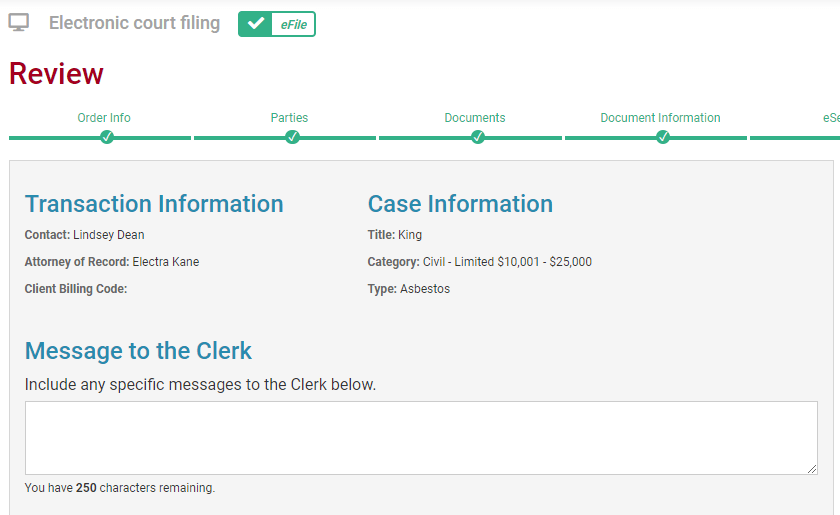Although electronic court filing removes a lot of the hassle from the filing process, eFiling also cuts way down on the human interaction. And while that’s part of the convenience, it can be hard when there’s no one with a face to talk with when something about your filing needs context.
For instance, in the physical filing world, a filer might include a cover letter for the clerk letting her/him know anything pertinent to the filing. Now, some EFSPs, like One Legal, have enabled a message to the clerk box to provide the same opportunity to the eFiling world.
At the end of the eFiling process, look for the “Message to the clerk” text box, a designated place for filers to write notes to the clerk who will be reviewing the filing.

And what would a filer write in that box, you might ask?
What to write
Here’s a list of things that a filer might put into the court message box:
#1 Alternate hearing dates
You’ve checked the court’s calendar on its website to confirm availability; you’ve chosen a date that is far enough in the future, yet well within your deadline. So you go ahead and select your hearing date and proceed with your eFiling.
Unfortunately, most courts do not integrate their calendars with the EFSP, so there is still no guarantee that your hearing date will be available when you file. One way to give the clerk an option besides rejecting your filing due to unavailability, is to suggest a few alternate dates that would also work. It is still ultimately up to the clerk, but this way you provide yourself with some breathing room.”
#2 About filing fees
The message to the clerk box is also a good place to communicate anything about filing fees. If a fee was already paid, make a note of that here, including, if possible, the date it was paid.
If a fee is still owed, let the clerk know how much to assess. If the client is exempt from filing fees for whatever reason, put it in the notes, in addition to uploading the fee waiver where noted. When it comes to communicating, more is better.
#3 Exceeding file size
While most documents are well within the file size limits of their court and its systems, some particularly large documents or combination of documents don’t quite make the cut. Try using the message to the clerk box if you know your document exceeds the file size limit, and you’ll have to split the filing in two.
Read more: 5 ways to reduce the size of a PDF>>
If you couldn’t fit your motion and supporting docs into one transaction, include a message to the clerk that confirms that your filing is part of court transaction #XXXXXX, filed on 00/00/00.
#4 Adding a document
Or maybe you forgot to submit a document with the initial order and need to submit it separately. You might avoid a rejection by filing the second document quickly but be sure to write the transaction number for the first filing in the message box of the second.
#5 Running statute
A statute that is running is also a good reason to utilize this functionality. Let the clerk know on what date it runs and add your direct line or email address so you can be easily and quickly reached in the event of a problem.
#6 Resubmission of a previously rejected document
Adding a note if your filing had previously been rejected is one way to confirm that you have addressed the issue. It also conveys to the clerk that you have thoroughly checked this version of the filing, as well as denoting a sense of urgency, lest you lose any more time for your filing.
What not to write
It’s important to note that not all clerks are guaranteed to read this message. Just as, unfortunately, it’s not guaranteed that clerks will give a reason for rejecting your document.
The fact is that for decades, attorneys would attach formal letters to filings requesting that the clerk would, indeed, file the document. Years of practice throwing these letters away as pointless has instilled in many clerks a habit of ignoring and trashing what they see as superfluous and not critical to the process.
Given this history, we do not recommend that filers use this message box to say, “Thank you for filing!” or “Please file,” or “Have a nice day!” While considerate, messages like these will only reinforce that court clerks need not pay attention to these messages from the filer. Reserve this option for when you really want the clerk to pay attention, and you’ll save yourself and them some time.
Despite this background, many court clerks do read this section, and, if it’s in their power to do so, will act accordingly. It is not their mission in life to reject your filing. Really!
***
Have you ever left a comment to the clerk that ended up saving your filing? Share your experience in the comments!








